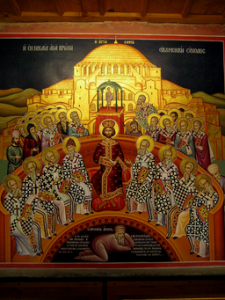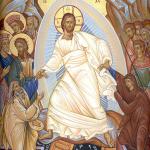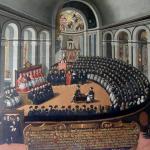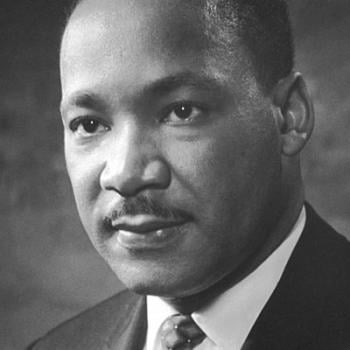
What is tradition?
David Bentley Hart has a habit of saying things that I have already begun to think. But he says them much better and with much more profundity and coherence. Sometimes, to be sure, he puts ideas in my head that weren’t there before. More often, though, he confirms my intuitions and helps me work out their implications in a more systematic way.
That’s definitely the case for the book of his I’ve read most recently, Tradition and Apocalypse. I’ve known the argument and read bits of it, and I’ve read a number of critical reviews, but only just finished reading the whole book. (It’s not a long book but I get distracted easily.) In this book, Hart tackles the question: what do we as Christians mean by “tradition”? He is of course speaking for and to Christians for whom tradition is a positive and important concept, not low-church Protestants who are suspicious of the whole thing.
The tradition of the anti-traditionalists
I grew up, as I’ve said before, in a radical Christian family who regarded much of institutional Christianity as corrupt. We didn’t think of tradition as a good thing. At least, we wouldn’t have used that term. We did think it was important to follow “the old paths” and to steep ourselves in the wisdom of the saints of the past. So we certainly had our own concept of tradition. But we tended to assume that the “old paths” had nearly always been sparsely followed, and that the true heritage of Christianity was likely to be found among people marginalized or persecuted in their own day. My grandmother wrote a book called Him or It? arguing that Christian history had been characterized by a persistent tendency to substitute something else for Jesus, while God had always raised up people to call us back to true, Christ-centered Christianity. (I helped her with the book and among other things toned down the anti-Catholic rhetoric. When the book went to press, by which time I had gone off to grad school and become interested in becoming Catholic, I found that she had put the rhetoric back and even intensified it.)
In other words, even “anti-traditional” Christians have a conception of tradition. They just may not call it that. And even supposedly “traditional” Christians, such as Catholics and Orthodox, have a much more complicated relationship with tradition than their rhetoric typically implies. Both traditions (and some Protestants as well) tend to speak as if there were an easily identifiable “true tradition” that has been more or less the same throughout the centuries. This rhetoric goes back to early Christianity, where it was commonplace to claim that orthodoxy was ancient and unified while heresy was recent and diverse. During the Reformation and for centuries after it, this assumption continued to dominate religious controversy. No matter one’s position, the goal was to show that one’s views were older than those of one’s opponents and more representative of a true, universal Christianity.
The diversity of early Christianity
Modern scholarship has put some serious dents in this picture of the history of Christian doctrine, to put it mildly. The classic book on the subject is Walter Bauer’s Orthodoxy and Heresy in Earliest Christianity. While many aspects of Bauer’s argument would be questioned by scholars today, the core thesis has become dominant among historians of early Christianity. This is that what we think of as “orthodox” Christianity today was originally one of many competing early Christian groups, which did not have an obvious, objective superiority to the others in terms of historicity or universality. Bauer suggests, for instance, than in some areas such as Edessa the earliest forms of Christianity may well have been “heretical,” and that Ignatius of Antioch was the leader of one faction within Antioch rather than of something that an observer would have been able to recognize as the normative expression of Christianity in the city.
The discovery of the Nag Hammadi texts and other examples of “Gnostic” and other “heretical” literature has tended to strengthen this way of thinking about early Christianity. The details can be argued, but the basic picture of early Christian diversity is commonly accepted among scholars. There are exceptions, particularly among conservative evangelicals such as Michael Kruger. But most scholars of a wide range of religious commitments would agree that early Christianity was made up of a number of rival movements, one of which, the “proto-orthodox” who called themselves “the Catholic Church,” eventually gained dominance over the others. The proto-orthodox were already the mainstream by the time of Constantine, which is probably why Constantine chose to favor them. (Constantine didn’t himself seem to have cared too much about theological disputes–he just wanted one institution that he could establish as a religiously unifying force within the empire.) However, their complete dominance over their rivals was in fact the work of the Christian Empire, which actively suppressed the remaining alternatives.
Controversies of the imperial Church
The formation of this “imperial Church” in the fourth century, however, opened up a whole set of new controversies. Because there was plenty of theological diversity within the early “Catholic” or “proto-orthodox” church as well as outside it. As Hart points out in Tradition and Apocalypse, this diversity was much less of a problem before Constantine. The greater level of communication among local Christian communities that resulted from Christianity’s new status, as well as the pressure to provide official moral and spiritual guidance to society as a whole, led Christians to become much more concerned with fine points of theological difference.
The first and most important controversy following on the legalization of Christianity was, of course, the controversy over the relationship of the Son to the Father which erupted in the late 310s and led to the Council of Nicaea in 325. This “Arian” controversy led to the first “Ecumenical Council” and to the adoption of the Nicene Creed, still (in its 381 revision) the most universally professed Christian statement of belief. It became the paradigm for all later theological controversies.
Which tradition? Whose orthodoxy?
In traditional Trinitarian Christianity, the controversy has often been framed as a conflict between those who defended the historic belief in the divinity of Jesus and a heretic called Arius who denied it. (Many people mistakenly think that Arius thought Jesus was just a human being. In fact he believed Jesus was a pre-existent being and in some sense divine, but of lower status than the Father and created by Him.) And on the other side, Muslims and anti-Trinitarian Christians (and many non-believers) often speak as if the Trinity were just something made up at the Council of Nicea. In fact, things were much more complicated than that.
The “Catholic Church” of the pre-Nicene era had historically proclaimed God as Father, Son, and Holy Spirit. Tertullian had begun using the word “Trinity” at the turn of the third century. That speaking of God involved, in some sense, speaking of a threeness as well as a oneness was not a new teaching. But as Hart points out, the mainstream “Catholic” view during the second and third centuries was a form of “subordinationism.” Most theologians believed that the Logos, who would become incarnate as Jesus, was in some way lesser than the Father and thus could mediate the Father to us. Drawing on passages such as John 1:18, they argued that the Father was unknowable, while the Son was not. Only the Son knew the Father, and thus could transmit a partial knowledge of the Father to us.
The erosion of the middle ground
Arius did go beyond the consensus by arguing that the Son had a beginning and should be firmly put in the category of “creature” over against the uncreated Father. (By putting the subordinationist position so starkly, he provoked a debate that destroyed the traditional position, which now seemed hopelessly vague and muddled. The Council of Nicea raised the stakes by making the criterion of orthodoxy a novel term, “homoousios” (of one substance), which has previously been used only by heretics. This seemed to many people a solution worse than the problem. Hence, lots of Christians in the fourth century, especially in the East, rejected Nicea. That didn’t mean that they were followers of Arius or agreed with Arius’ theology on the whole. But they sought to find some way to preserve both sides of the traditional position–the claim that the Son was divine and not simply a creature, and the claim that the Son was clearly lesser than the Father.
By the end of the fourth century, this middle ground had largely eroded. The two leading contenders were full-blown Trinitarianism, especially as formulated by the “Cappadocian” theologians, and a radical “Arian” position associated with the theologian Eunomius (who wasn’t himself a follower of Arius and whose theology was rather different from that of Arius). In other words, it had become clear to many by the Council of Constantinople in 381 that the Son must either be fully divine or not divine at all.
The innovation of orthodoxy
One of the major arguments of Tradition and Apocalypse is that this was a real innovation in Christian theology. It was not simply the defense of an older position against a new heresy. And even the more nuanced claim that it was a needed clarification in the face of a new challenge isn’t quite right, given how different the Trinitarian theology of the late fourth century is from the sort of theology that would have been accepted as orthodox a century before.
Hart puts this perhaps more strongly than I would by saying that Arius was simply “a traditional Alexandrian believer” and “clearly operating within the ambit of the faith as he had received it from a long Christian past” (p. 119). Hart doesn’t seem to think that Arius’ claim that the Son had a beginning went beyond the consensus, as I claimed above. And he’s more learned in these matters than I so he may be right, or he may possibly be overstating things a bit as he sometimes does. Where he’s clearly right is to say that the theological debates of the fourth century really did lead to a new way of thinking about God. And any appeal to those debates as a model for contemporary controversies over the limits of orthodoxy has to take that fact into account.
So what is tradition? To be continued. . . .
Given these two factors–the diversity of early Christianity and the novelty of key elements of what came to be accepted as orthodoxy–in what sense can we speak, with integrity, of a coherent Christian tradition? What does it mean to be faithful to the tradition? Is the tradition really anything more than simply the result of “power plays” and self-interested reconstructions of history long after the fact? Tradition and Apocalypse sets out to answer that question. In the next post, I’ll discuss how Hart criticizes the most influential attempt (at least in a Catholic context) to argue for the coherence of the concept of Christian tradition: John Henry Newman’s Essay on the Development of Christian Doctrine. Then I’ll talk about Hart’s own answer, why I think it’s fundamentally right, and the problems that I have with it.












